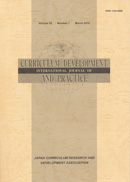Volume 11, Issue 1
Displaying 1-5 of 5 articles from this issue
- |<
- <
- 1
- >
- >|
-
Article type: Article
2009Volume 11Issue 1 Pages 1-12
Published: 2009
Released on J-STAGE: January 07, 2018
Download PDF (885K) -
Article type: Article
2009Volume 11Issue 1 Pages 13-23
Published: 2009
Released on J-STAGE: January 07, 2018
Download PDF (938K) -
Article type: Article
2009Volume 11Issue 1 Pages 25-34
Published: 2009
Released on J-STAGE: January 07, 2018
Download PDF (820K) -
Article type: Article
2009Volume 11Issue 1 Pages 35-49
Published: 2009
Released on J-STAGE: January 07, 2018
Download PDF (1223K) -
Article type: Article
2009Volume 11Issue 1 Pages 51-59
Published: 2009
Released on J-STAGE: January 07, 2018
Download PDF (672K)
- |<
- <
- 1
- >
- >|
